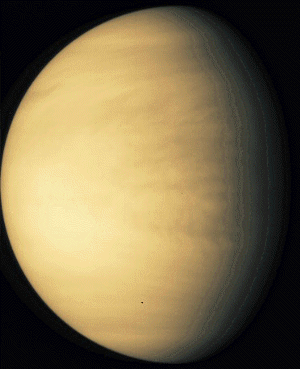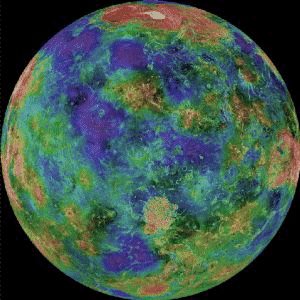
Beauty Is Only Skin Deep
This is a picture of Venus taken by the Galileo spacecraft on its way to Jupiter. Who would guess that such a beautiful planet could be so violent on the surface?
Venus is the second planet from the Sun, located in between Mercury and Earth. The orbit, or path, Venus follows around the Sun is nearly circular, so the planet's distance from the Sun averages about 65 million miles. Being closer to the Sun, a Venusian year is just 225 days. Venus spins more slowly than Earth, so a day on Venus is 243 days, which means that a day on Venus is longer than it's year! Even more strange is the fact that Venus rotates from East to West, which is just the opposite of Earth and most of the other planets.
You can see Venus for several months each year, either in the morning or evening sky, and you don't need a telescope. Venus is called both the morning and evening star, and ancient astronomers thought it was two different objects. When it is visible, Venus is the second-brightest object in the sky, being outshone only by the Moon. You would never guess that something that is so beautiful could be so unpleasant. Since Venus is closer to the Sun than we are here on Earth, you could see the planet going through phases like our Moon does if you have a telescope.

Radar Map of Venus
The Magellan spacecraft made this "radar map" of Venus. Scientists here on Earth then took the radar information, translated it and created a map showing what color the planet might be if we could see though the clouds.
Venus is almost the same size as Earth, with a diameter of a little over 7200 miles. This is, thankfully, the only way that Venus is similar to Earth.
Venus was named for the goddess of love and beauty. This is definitely a case of beauty being only skin deep, as Venus is a very unpleasant place, with winds that blow hundreds of miles an hour, and temperatures that are hot enough to melt most metals!
Venus is one of the solar system's rocky planets, along with Earth and Mercury. The planet has an iron core, which is covered by a rocky layer. This rocky layer has a lot of lava, which has been generated by the many volcanoes on its surface.
To put it mildly, Venus is an extremely unpleasant place. The bright white light that we see from Earth is a result of sunlight being reflected off the clouds that completely cover the planets surface. These clouds are made of sulfuric acid, which is an extremely dangerous substance. When you get to the planet's surface, things get even worse. The temperature on Venus averages around 900 degrees Fahrenheit, which is hot enough to melt lead! That's not all, the clouds on Venus have created an atmosphere that is the same as being half a mile underwater here on Earth. The air pressure would be enough to crush some submarines. Finally the winds on Venus are almost always faster than a tornado, averaging around 240 miles per hour! The few spacecraft that have managed to land on Venus have lasted less than an hour before the heat and air pressure have melted and crushed them. For this reason, a lot of what we know about the surface of Venus has come from spacecraft that have studied the planet from a safe distance. We have also been able to map some of the planet's surface using radar telescopes here on Earth. What we have found is that Venus has a surface that has many mountains (some higher than Mount Everest), volcanoes and plains filled with lava.

Terrain Map of Venus
This is a terrain (or topographic) map of Venus. The Magellan spacecraft made a radar map of the planet's surface. Scientists here on Earth then took the radar map and made this color image. The blue areas are the low-lying areas of the planet's surface. The areas get higher and higher as the color goes from blue through green all the way to red.
Back To Main Menu
Use the "BACK" button on your Browser to return to the previous page.